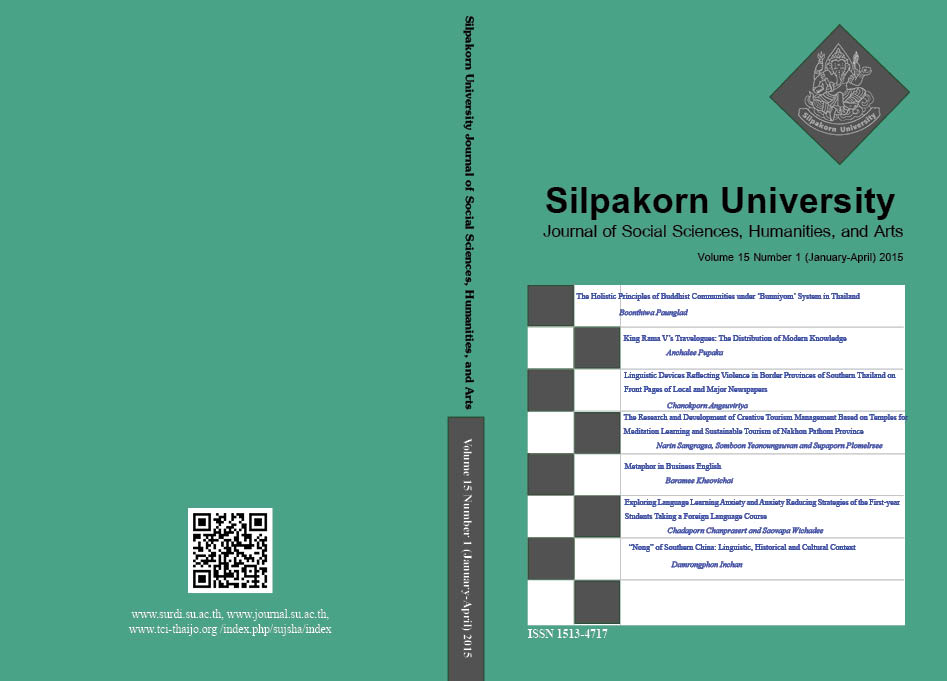“Nong” of Southern China: Linguistic, Historical and Cultural Context
Main Article Content
Abstract
Nong people are a branch of Zhuang nationality, settling in Yunnan and Guangxi of Southern China. Like Vietnam’s Nùng, they live in border areas. The autonyms and exonyms referring to them show that there are various branches of Nong around these areas. This paper presents the linguistic classification of Nong/Nung language first. Then, some historical evidences and anthropological perspectives, gathered from surveys and documents about Nong ethnic groups in Southern China, are additionally proposed. According to some phonological criteria, Proto-Tai linguistic classification grouped Nung/Nong as a subgroup of Central Tai. There are arguments amongst scholars whether some Nong dialects in Southern China can be also identified as a subgroup of Northern Tai dialects or not. According to the historical records and ethnohistory, a rebel leader of Nong in 11th century named Nong Zhigao became interesting information for further researches. Nowadays, even though Nong people are culturally influenced by Han Chinese, they still maintain their ancestral culture and tradition.
Downloads
Article Details
All rights reserved. Apart from citations for the purposes of research, private study, or criticism and review,no part of this publication may be reproduced, stored or transmitted in any other form without prior written permission by the publisher.
References
Barlow, J. (2001) The Zhuang. [Online URL: http://mcel.pacificu.edu/as/resources/zhuang/] accessed on June, 2001.
Barlow, J. G. (1987) The Zhuang minority peoples of the southern Sino-Vietnamese frontier in the Song period. Journal of Southest Asian Studies 18(2): 250-269.
Barth, F. (1969) Ethnic Groups and Boundaries: the Social Organization of Cultural Difference. Boston, Massachusetts: Little Brown.
Chamberlain, J. R. (1998) A Critical Framework for the Study of Thao Houng or Cheuang. In Legends about Thao Houng Thao Cheuang: Historical and Cultural Dimension, edited by Dejsupha, N., pp. 1-11. Bangkok: Thai Khadi Research Institute, Thammasat University in coordination with the Office of the National Cultural Committee, Ministry of Education.
Evans, G., Hutton, C. and Kuah, K. E. (2000) When China Meets Southeast Asia: Social and Cultural Changes in the Border Regions. Bangkok: White Lotus.
Dejsupha, N. (Editor). (1998) Legends about Thao Houng Thao Cheuang: Historical and Cultural Dimension. Bangkok: Thai Khadi Research Institute, Thammasat University in coordination with the Office of the National Cultural Committee, Ministry of Education.
Gedney, W. J. (1989) Selected papers on comparative Tai studies, edited by Bickner, J. R., Hudak, T. J., Hartmann, J. and Peyasantiwong, P. (Michigan papers on South and Southeast Asia center for south and Southeast Asian studies, the University of Michigan. Number 29). Ann Arbor: University of Michigan center for South and Southeast Asian Studies.
Fan, H. (2000) Tong gen sheng de min zu- Zhuang Tai ge zu yuan yuan yu wen hua (The national of the same origin: origin of Zhuang and Tai nationality and culture). In Quangning Daily Press. (Chinese)
He, Z. (1998) Yunnan Zhuang Nationality. Yunnan: The Ethnic Publishing House.
He, Z. (1999) Briefly introduced about Mo Hog Tay Scripture of Pu Nong. Presented paper for international conference Before Civilized Tais, held by Thai Khadi Research Institute at Princess Maha Chakri Sirindhorn Anthropology Centre (Public Organization). (Translated in Thai)
He, Z. (2003) From Nung Zhigao’s leading his Army to Live in Yuan River to Study Zhuang and Dai’s Relationship. Unpublished. (Chinese)
Hoang, L. (1998) Nùng Trí Cao in the History of Vietnam. In Legends about Thao Houng Thao Cheuang: Historical and Cultural Dimension, edited by Dejsupha, N., pp. 98-100. Bangkok: Thai Khadi Research Institute, Thammasat University in coordination with the Office of the National Cultural Committee, Ministry of Education.
Inchan, D. (2013) “Nung” of Southern China: their historical, linguistic and cultural backgrounds. Unpublished doctoral dissertation, Thammasat University, College of Interdisciplinary Studies.
Johnson, E. (2010) A Sociolinguistic Introduction to the Central Taic Languages of Wenshan Prefecture, China. SIL Electronic Survey Reports.
Kaup, K. P. (2000) Creating the Zhuang: ethnic politics in China. Boulder Colorado: Lynne Rienner Publishers.
Keyes, C. F. (2002) President Address: “The Peoples of Asia” - Science and Politics in the Classification of Ethnic Groups in Thailand, China, and Vietnam. The Journal of Asian Studies 61(4): 1163-1203.
Kullavanijaya, P. and L-Thongkum, T. (1998) Linguistic criteria for determining Tai ethnic groups: case studies on Central and Southwestern Tais. Paper presented at International conference on Tai Studies organized by the Institute of Language and Culture for Rural Development, Mahidol University, Bangkok, July 29-31, 1998.
Lewis, M. P. (Editor). (2009) Ethnologue: Language of the World, 16th ed., Dallas, Texus: SIL International. [Online URL: http://www.ethnologue.org/show_family.asp?subid=841-16] accessed on June 13, 2010.
Najchumnong, T. (1989) Zhuang in China and Haw’s hand. Art and Culture (6th April): 133. (Thai)
Pitiphat, S. and Poolsuwan, S. (2000) “Tai” and “Zhuang” in Yunnan, China: The analysis from fieldwork. Bangkok: Thai Khadi Research Institute, Thammasat University. (Thai)
Pittayaporn, P. (2009) The Phonology of Proto-Tai. Unpublished doctoral dissertation, Faculty of the Graduate School, Cornell University.
Thuat, D. T. (1996) Tay- Nùng language in the North Vietnam. Tokyo: Institute for the Study of Language and Cultures of Asia and Africa (ILCAA), Tokyo University of Foreign Studies.
Wang, M. (2008) Na Wenhua Tanyuan (Tracing “Na Culture” to its Source). Yunnan: Wenshan Zhuang and Miao Autonomous Prefecture Minority Affairs Commission’s Bureau of Ancient Document. (Chinese)
Wang, M. and Johnson, E. C. (2008) Zhuang Cultural and Linguistic Heritage. Yunnan: The Nationalities Publishing House of Yunnan.


